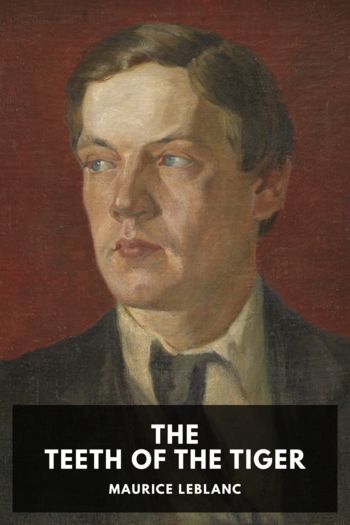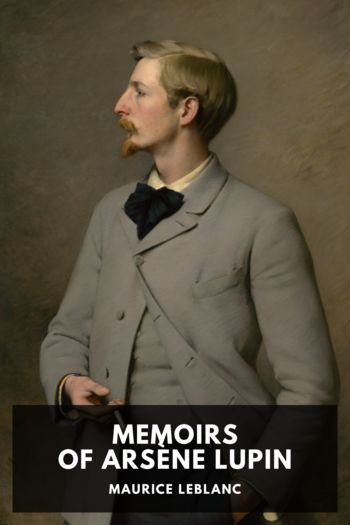The Teeth of the Tiger, Maurice Leblanc [top 10 inspirational books TXT] 📗

- Author: Maurice Leblanc
Book online «The Teeth of the Tiger, Maurice Leblanc [top 10 inspirational books TXT] 📗». Author Maurice Leblanc
It consisted of a broad, circular band in brass, beneath which was a festoon of crystal pendants. Inside were three lamps placed at the corners of a brass triangle concealing the wires.
He uncovered the wires and cut them. Then he began to take the whole fitting to pieces. To hasten matters, he asked for a hammer and broke up the plaster all round the clamps that held the chandelier in position.
“Lend me a hand, please,” he said to Mazeroux.
Mazeroux went up the steps; and between them they took hold of the chandelier and let it slide down the uprights. The detectives caught it and placed it on the table with some difficulty, for it was much heavier than it looked.
On inspection, it proved to be surmounted by a cubical metal box, measuring about eight inches square, which box, being fastened inside the ceiling between the iron clamps, had obliged Don Luis to knock away the plaster that concealed it.
“What the devil’s this?” exclaimed M. Desmalions.
“Open it for yourself, Monsieur le Préfet: there’s a lid to it,” said Perenna.
M. Desmalions raised the lid. The box was filled with springs and wheels, a whole complicated and detailed mechanism resembling a piece of clockwork.
“By your leave, Monsieur le Préfet,” said Don Luis.
He took out one piece of machinery and discovered another beneath it, joined to the first by the gearing of two wheels; and the second was more like one of those automatic apparatuses which turn out printed slips.
Right at the bottom of the box, just where the box touched the ceiling, was a semicircular groove, and at the edge of it was a letter ready for delivery.
“The last of the five letters,” said Don Luis, “doubtless continuing the series of denunciations. You will notice, Monsieur le Préfet, that the chandelier originally had a fourth lamp in the centre. It was obviously removed when the chandelier was altered, so as to make room for the letters to pass.”
He continued his detailed explanations:
“So the whole set of letters was placed here, at the bottom. A clever piece of machinery, controlled by clockwork, took them one by one at the appointed time, pushed them to the edge of the groove concealed between the lamps and the pendants, and projected them into space.”
None of those standing around Don Luis spoke, and all of them seemed perhaps a little disappointed. The whole thing was certainly very clever; but they had expected something better than a trick of springs and wheels, however surprising.
“Have patience, gentlemen,” said Don Luis. “I promised you something ghastly; and you shall have it.”
“Well, I agree,” said the Prefect of Police, “that this is where the letters started from. But a good many points remain obscure; and, apart from this, there is one fact in particular which it seems impossible to understand. How were the criminals able to adapt the chandelier in this way? And, in a house guarded by the police, in a room watched night and day, how were they able to carry out such a piece of work without being seen or heard?”
“The answer is quite easy, Monsieur le Préfet: the work was done before the house was guarded by the police.”
“Before the murder was committed, therefore?”
“Before the murder was committed.”
“And what is to prove to me that that is so?”
“You have said so yourself, Monsieur le Préfet: because it could not have been otherwise.”
“But do explain yourself, Monsieur!” cried M. Desmalions, with a gesture of irritation. “If you have important things to tell us, why delay?”
“It is better, Monsieur le Préfet, that you should arrive at the truth in the same way as I did. When you know the secret of the letters, the truth is much nearer than you think; and you would have already named the criminal if the horror of his crime had not been so great as to divert all suspicion from him.”
M. Desmalions looked at him attentively. He felt the importance of Perenna’s every word and he was really anxious.
“Then, according to you,” he said, “those letters accusing Madame Fauville and Gaston Sauverand were placed there with the sole object of ruining both of them?”
“Yes, Monsieur le Préfet.”
“And, as they were placed there before the crime, the plot must have been schemed before the murder?”
“Yes, Monsieur le Préfet, before the murder. From the moment that we admit the innocence of Mme. Fauville and Gaston Sauverand, we are obliged to conclude that, as everything accuses them, this is due to a series of deliberate acts. Mme. Fauville was out on the night of the murder: a plot! She was unable to say how she spent her time while the murder was being committed: a plot! Her inexplicable drive in the direction of La Muette and her cousin Sauverand’s walk in the neighbourhood of the house: plots! The marks left in the apple by those teeth, by Mme. Fauville’s own teeth: a plot and the most infernal of all!
“I tell you, everything is plotted beforehand, everything is, so to speak, prepared, measured out, labelled, and numbered. Everything takes place at the appointed time. Nothing is left to chance. It is a work very nicely pieced together, worthy of the most skilful artisan, so solidly constructed that outside happenings have not been able to throw it out of gear; and that the scheme works exactly, precisely, imperturbably, like the clockwork in this box, which is a perfect symbol of the whole business and, at the same time, gives a most accurate explanation of it, because the letters denouncing the murderers were duly posted before the crime and delivered after the crime on the dates and at the hours foreseen.”
M. Desmalions remained thinking for a time and then objected:
“Still, in the letters which he wrote, M. Fauville accuses his wife.”
“He does.”
“We must therefore admit either that he was right in accusing





Comments (0)